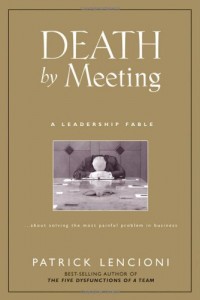[Insert image]
Blog readers please note: Starting in 2016, I will be routinely posting content from one of the most innovative content sources in the church world: SUMS Remix Book Summaries for church leaders. SUMS Remix takes a practical problem in the church and looks at it with three solutions with each solution taken from a different book. As a church leader you get to scan relevant books based on practical tools and solutions to real ministry problems, not just by the cover of the book. Each post will have the edition number which shows the year and what number it is in the overall sequence. (SUMS Remix provides 26 editions per year, delivered every other week to your inbox).
>>You can purchase a subscription to SUMS Remix here >>>
There’s nothing more annoying than a meeting that goes on and on and on – except maybe a meeting that goes on and on and on AND doesn’t accomplish anything.
Many ministry teams fritter away precious time during meetings on unfocused, inconclusive discussion rather than rapid, well-informed decision making. The consequences are delayed decisions that lead to wasted resources, missed opportunities, and poor long-range planning.
Want more successful meetings? Patrick Lencioni, noted leadership consultant, believes that most team meetings are ineffectual because they lack contextual structure. Meetings can become more effective when organizations establish multiple types of meetings and clearly distinguish between the various purposes, formats, and timing of those meetings.
Solution #1: Establish multiple types of meetings to give each one a clear purpose.
 THE QUICK SUMMARY
THE QUICK SUMMARYBest-selling author Patrick Lencioni provides readers with a thought-provoking book centered around a cure for the most painful yet underestimated problem of today’s organizations: bad meetings.
In Death by Meeting, Lencioni provides a framework for his groundbreaking model, and makes it applicable to the real world. The result is nothing short of a blueprint for leaders who want to eliminate waste and frustration among their teams, and create environments of engagement and passion.
A SIMPLE SOLUTION
Your organization can make the leap from painful, ineffective meetings to energetic, productive meetings by changing the context, purpose, and timing of meetings.
Organizations typically approach a meeting by having a regularly scheduled time in which team members cover a wide range of topics from strategy to policy to calendaring to personnel – and everything in between. All these topics are important, but which is most important? They all are – and that’s the problem.
The resulting hot mess almost always ends up being ineffective and unsatisfying for everyone, with participants wanting to get back to their real work.
To have effective meetings, establish multiple types of meetings and clearly distinguish between the various purposes, formats, and timing of those meetings.
The single biggest structural problem facing leaders of meetings is the tendency to throw every type of issue that needs to be discussed into the same meeting, like a bad stew with too many random ingredients.
The Four Meetings
There should be different meetings for different purposes, and each of them serves a valid function. Every organization should consider adopting something like the following structure, which involves four basic types of meetings.
Meeting #1: The Daily Check-in
The Daily Check-in requires that team members get together, standing up, for about five minutes every morning to report on their activities that day. The purpose of the Daily Check-in is to help team members avoid confusion about how priorities are translated into action on a regular basis.
Meeting #2: The Weekly Tactical
A Weekly Tactical lasts between forty-five and ninety minutes, and is focused exclusively on tactical issues of immediate concern. Elements include a Lightning Round where everyone indicates two or three priorities of the week; Progress Review which includes routine reporting of critical information or metrics; and Real-Time Agenda, about fifteen minutes into the meeting, based on what everyone is actually working on. The Goal of the Weekly Tactical is resolution of issues and reinforcement of clarity.
Meeting #3: The Monthly Strategic
The Monthly Strategic is where team members wrestle with, analyze, debate, and decide on critical issues (but only a few) that will affect the organization in fundamental ways. The goal of this meeting is for team members to dive into a given topic or two without the distractions of deadlines and tactical concerns.
Meeting #4: The Quarterly Off-Site Review
Effective off-sites provide a senior leadership team the opportunity to step away from the daily, weekly, and monthly issues in order to review the organization in a more holistic, long-term manner. Elements of this meeting include a Comprehensive Strategy Review, Team Review, Personnel Review, and a Trend Review.
Patrick Lencioni, Death by Meeting
A NEXT STEP
Most leaders wouldn’t think the answer to the inefficiency of meetings is to have more meetings, but when properly utilized, more meetings actually save time. Well-planned, topic-specific meetings held at the right time and for the right length improve execution by accelerating decision making and eliminating the need to revisit issues again and again.
Together with your leadership team, review the four types of meetings listed above, and sketch out how you can transition your current meeting structure to the Four-Meeting Model. Agree on a “trial period” of at least three months during which you will follow the model.
At the end of each month during the trial period, devote time during the Monthly Strategic meeting to briefly review progress and make minor adjustments.
At the end of the three-month trial period, devote 3-4 hours to a thorough review and evaluation. After making any final adjustments, continue the Four Meeting Model for the rest of your organizational year.
Taken from SUMS Remix 8, published February 2015
>>> You can purchase a subscription to SUMS Remix here >>>
